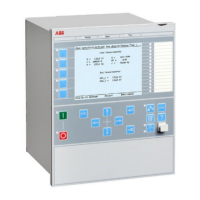7. Connect the test set to terminal L1 and neutral of the three-phase current input
configured to REFPDIF. Also inject a current higher than half the IdMin
setting in the neutral-to-
earth circuit with the same phase angle and with
polarity corresponding to an internal fault.
8. Increase the current injected in L1, and note the operate value. Decrease the
current slowly and note the reset value.
9. Inject current into terminals L2 and L3 in the same way as in step 7 above
and note the operate and reset values.
10. Inject a current equal to 10% of rated current into terminal L1.
11. Inject a current in the neutral-to-earth circuit with the same phase angle and
with polarity corresponding to an external fault.
12. Increase the current to five times the operating value and check that the
protection does not operate.
13. Finally check that trip information is stored in the event and disturbance
recorder.
11.3.2.2 Completing the test
SEMOD55252-118 v5
Continue to test another function or end the test by changing the TESTMODE
setting to Off. Restore connections and settings to their original values, if they were
changed for testing purposes.
11.3.3 Line differential protection L4CPDIF
GUID-3B2CCAFF-38B2-4C16-94F9-88B7D4B6F2B3 v2
Prepare the IED for verification of settings outlined in Section
"Preparing the IED
to verify settings".
The Line differential protection function (L4CPDIF) is tested with dif
ferent IEDs
geographically separated from each other. Local actions in one IED may cause
operation in remote IEDs, and this is why testing actions must be performed in all
involved IEDs.
When the L4CPDIF function in a local IED is set to test mode,
information on this is automatically sent to IEDs at remote ends.
The L4CPDIF functions at remote end IEDs are then also blocked
automatically.
Before testing the L4CPDIF function, the trip signal to the circuit breaker must be
blocked, for example, by applying the COMBITEST test switch.
The IED and all functions involved in the test must be set to test mode. The local
function is activated with setting ReleaseLocal. The trip function block must be
deblocked so that trip times can be measured.
In test mode, the injected current is communicated to the remote IEDs and then
sent back to the IED under testing. The echoed current is switched in phases so that
current in phase L1 is returned in phase L2, current in phase L2 is returned in phase
L3 and current in phase L3 is returned in phase L1. The amplitude of the returned
1MRK 505 378-UEN A Section 11
Testing functionality by secondary injection
Line differential protection RED670 2.2 IEC 107
Commissioning manual

